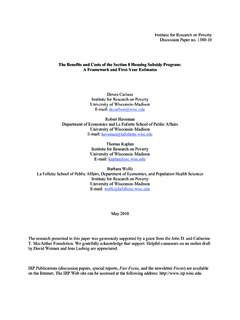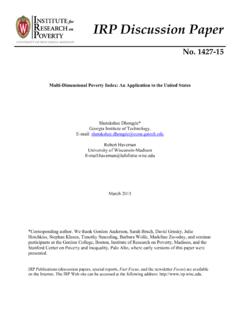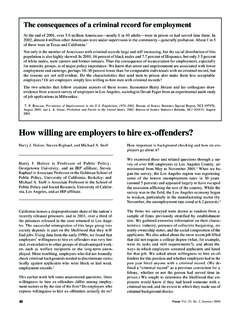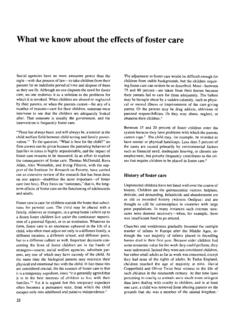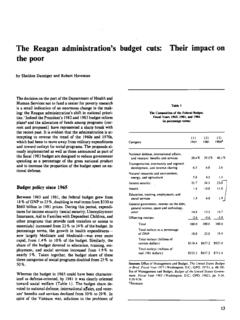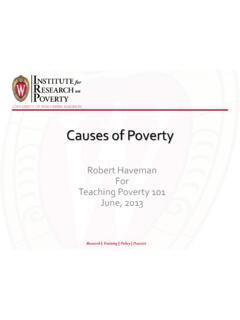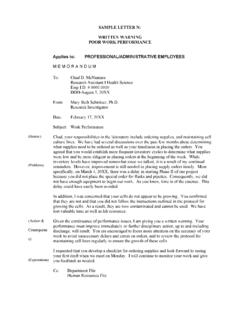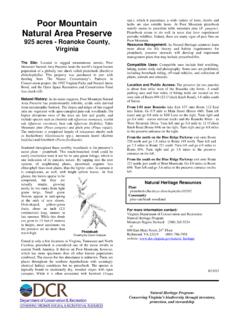Transcription of Health care for the poor: For whom, what care, and whose ...
1 69 Health care for the poor : For whom, what care , and whose responsibility ?with low income, such as low education, the inability to speak English, and residence in areas with high levels of pollution, also contribute to poor Equally important, the link between poverty and poor Health does not go in just one direc-tion. poor Health is a contributing factor to low incomes and poverty. People with chronic medical conditions frequently are poor because they cannot work, and people who suffer a sudden decline in Health often become poor after losing their job. Moreover, people with chronic illness often have difficulty accessing medical care because they are not good advocates for themselves and too few medical providers are nearby, and they then remain poor because they cannot fact that people in poor Health often have low incomes as a result of their Health problems is an increasingly important driver of efforts to expand eligibility for public insurance.
2 This is especially the case in efforts to increase coverage of chil-dren. As we have come to appreciate how poor Health can af-fect learning, which in turn is related to a person s productivity and earnings, awareness has grown that investing in ways to improve access to Health care pays off in areas beyond Health outcomes. Thus, the recent history of public policies to help poor people obtain Health care is an evolving mix of efforts to address the reasons poor people have poor Health . Some policies increase public insurance, and other initiatives are targeted at addressing language and cultural problems particu-lar to the poor or increasing the supply of medical providers knowledgeable about difficulties facing poor people. This article focuses on the recent history of public policies intended to help the poor obtain Health care , including the concerns now surrounding public insurance. Health care assistance for the poor , past and presentA brief history of major efforts to provide Health care to the poor since 1900 is shown in the box on this Two themes are apparent when examining the last century of Health care assistance for the poor .
3 First, there has been a preference for state rather than federal control of how Health care assistance is administered. Second, Health care assis-tance for the poor has been administered more as a welfare program than as part of a national system of financing Health insurance and medical care . Both themes have contributed to large disparities across states in who among the poor has access to what types of medical care . Recent state innovations in insurance programs for the poor and near-poorMedicaid enrollment increased between 2000 and 2007, partly because of increases in the number of people who ei-ther lost or were not offered employer-sponsored insurance. Katherine SwartzKatherine Swartz is Professor of Health Economics and Policy at the Harvard School of Public programs to help poor Americans obtain medical care have evolved as the country has grown richer and medical advances have increased life expectancy and improved quality of The evolution has not been a direct path of increased generosity towards poor people.
4 Instead, it reflects a mix of philosophical beliefs, greater understanding of the links be-tween Health and ability to work, and swings in the economy. Since the late 1940s, when the share of Americans with employer-sponsored, private Health insurance started to grow rapidly, the primary approach to helping poor people obtain medical care has been to make public Health insurance avail-able to a growing share of the poor . Underlying this approach is the assumption that if poor people have Health insurance, physicians and other providers of medical care will provide the same services to poor people as they do to middle-class people. But as experience with public insurance has grown, it has become clear that poor people face barriers to obtain-ing Health care beyond simply their inability to afford it. A shortage of physicians and nurses exists in many poor areas of the country, and not all physicians and other medical care providers are willing to treat people with public insurance coverage.
5 Many poor people are unaware of symptoms of medical need or do not know how to explain their symp-toms to medical personnel. Others face language or cultural difficulties when seeking care . As understanding of these barriers has increased, efforts to help low-income people obtain Health care have expanded to include more funding for community Health centers, public Health clinics, language translators, and educational programs about Health issues specifically targeted at groups of poor people. These public policy efforts, however, have been secondary to expanding Health insurance coverage for low-income dramatic increase over the past 50 years in medicine s ability to increase life expectancy and improve quality of life (especially for people with chronic conditions) has made disparities in access to Health care more troubling. There is no doubt that poverty is a contributing factor to poor Health outcomes. poor people have lower life expectancies, higher prevalence of chronic illnesses and Health conditions, and more unmet Health needs than people with middle-class and high incomes.
6 But the causal path between poverty and poor Health outcomes is complex. Other factors that are correlated Focus Vol. 26, No. 2, Fall 200970In 2007, 55 percent of the nonelderly uninsured had incomes below 200 percent of the poverty level; and almost a third of all nonelderly people with incomes below 200 percent of the poverty level were uninsured (Table 1). Most of these unin-sured people were not eligible for Medicaid because they either did not meet categorical eligibility requirements or they had incomes exceeding their state s eligibility ceiling. In response to the growing number of uninsured working people, several states created programs in the early 2000s to expand eligibility for public insurance or encourage low-income people who were not eligible for Medicaid to buy private Health insurance with state subsidies. The states did this not only to expand coverage but also to reduce pressures on hospitals and physicians who were providing more un-compensated care to the uninsured.
7 Three programs of note, described briefly below, are described in detail in the book chapter. Healthy New York, started in 2001, is available for people who are not eligible for Medicaid but whose income is below 250 percent of the poverty level. Commonwealth care , implemented in late 2006 by Massachusetts, provides a choice of four managed care plans (with some further choice of benefits depending on a person s income) to people who do not qualify for Medicaid but have incomes below 300 per-cent of the poverty level. BadgerCare Plus began enrolling children under 19 years of age in Wisconsin in early 2008. The program is open to all children regardless of income who do not have access to Health insurance, as well as self-employed parents, pregnant women with annual incomes up to 300 percent of the poverty level, and farmers. History of Major Efforts to Provide Health care to the poor Since 19001900 1935: Medical care assistance provided ad hoc by civic and religious groups, primarily to deserving poor 1935 1945: Social Security Act passed, rise of public hospitals and clinics for poor , beginning of two-tiered system of medical care1945 1965: Private insurance coverage expands, setting the stage for Medicaid 1965: Medicare and Medicaid Implemented1984 1990: Expansion of Medicaid 1990s: Efforts to slow Medicaid spending growth, waivers, and welfare reform1997: Creation of the State Children s Health Insurance Program (SCHIP) Early 2000s.
8 Efforts to control Medicaid spending growth and state experiments to expand options for poor peopleTable 1 Distribution of Nonelderly Uninsured by Income Relative to Poverty, 2007 Family IncomeRelative to PovertyNumber Uninsured(millions)Percentof UninsuredPercent ofCohortUninsuredBelow poverty x x poverty x x x poverty and : Author s tabulations of March 2008 Current Population Health Centers: An alternative to insurance coverage for the poor ? Since the War on Poverty was initiated in 1965, the federal government has funded Community Health Centers (CHCs) to provide medical care to the poor and uninsured. Over the last four decades, levels of enthusiasm for and disillusion-ment with these public providers of medical care have waxed and waned. Proponents of CHCs argue that they take better care of the Health problems of low-income people because they know more about their clients lives their living conditions, willingness to discuss symptoms and tendency to follow directions about prescriptions or nutrition than medical personnel in physicians offices or Health plans.
9 They argue that expanding public Health insurance programs is less efficient than expanding a quarter of the people served by CHCs are uninsured while the rest are covered by public insurance, and almost two-thirds are members of minority or immigrant Despite a recent increase in funding for CHCs, there is a con-sensus of opinion that uninsured patients at CHCs who need specialty services, including diagnostic tests and medically necessary referrals for medical specialists and mental Health and substance abuse services, face greater difficulties than do Medicaid Most analysts believe that CHCs need additional resources to provide better quality care , though it is not yet known whether it is more cost-effective to expand CHCs than to expand public insurance programs that pay for care by all types of providers. Current concerns with public Health insurance programsBeyond concerns about the rising costs of Medicaid, SCHIP, and other public Health programs, there are four major con-cerns about how these programs collectively meet the needs of low-income people.
10 Quality of care for elderly and disabled beneficiaries Medicaid is the largest source of financing for long-term care ; elderly and disabled beneficiaries make up only 25 per-cent of Medicaid enrollees, but account for about 70 percent of Recent efforts to limit Medicaid spending on elderly and disabled beneficiaries have focused on restrict-71 Health Insurance in the United StatesA brief explanation of the broad types of Health insurance now held by Americans is useful for understanding why the primary approach to helping poor people obtain medical care has been to expand eligibility for public Health insurance. About 61 percent of people younger than 65 years old have employer-sponsored, private Health insurance. Another 5 percent of the nonelderly have insurance policies that they buy themselves in the individual (or non-group) insur-ance market from private insurance companies. In addition, about 3 percent have military or Veterans Administration coverage and 2 percent to 3 percent have Medicare (either because they have end-stage renal disease or are otherwise disabled and cannot work).


